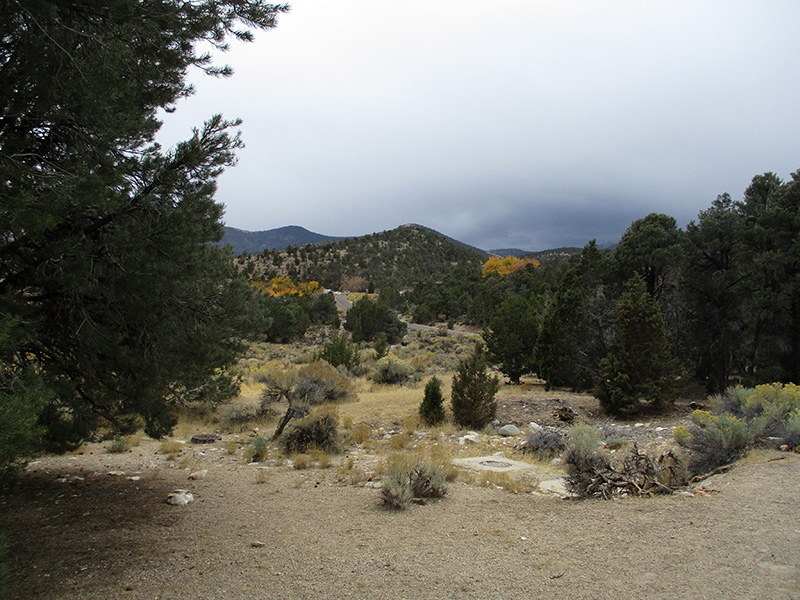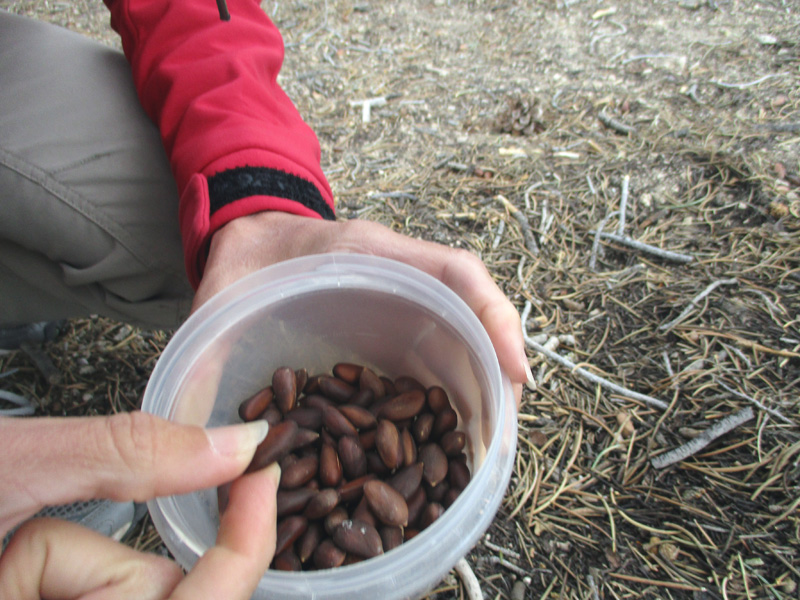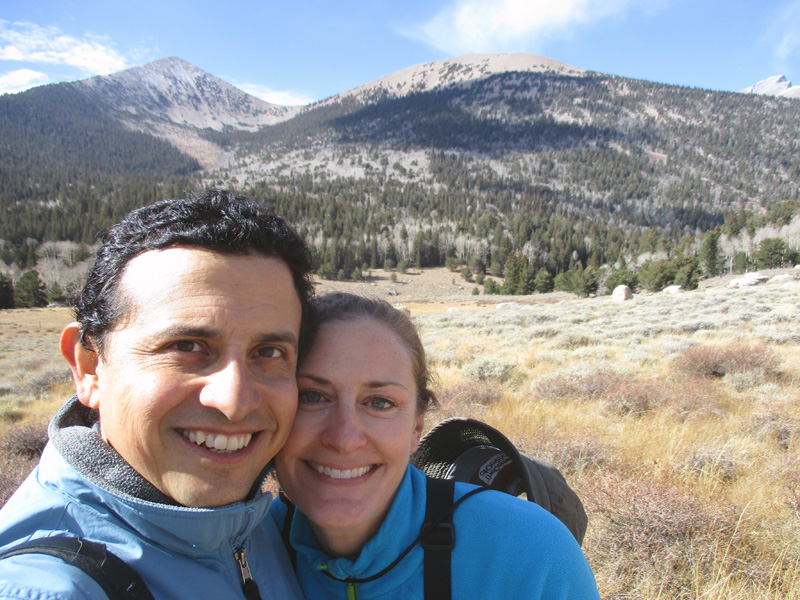 Sometimes the smaller parks few people have heard of provide the most delightful surprises. That was the case with Great Basin National Park, a 77,000-acre park set in a rather desolate-looking desert near the Utah-Nevada border. The Great Basin region spans almost the entirety of Nevada and half of Utah along with small portions of California, Oregon and Wyoming. This large swath of land used to be an enormous lake bed punctuated by mountains. Rather than flowing into the sea, rains in the mountain ranges here drain into a closed system of basins and often evaporate into dry flatlands.
Sometimes the smaller parks few people have heard of provide the most delightful surprises. That was the case with Great Basin National Park, a 77,000-acre park set in a rather desolate-looking desert near the Utah-Nevada border. The Great Basin region spans almost the entirety of Nevada and half of Utah along with small portions of California, Oregon and Wyoming. This large swath of land used to be an enormous lake bed punctuated by mountains. Rather than flowing into the sea, rains in the mountain ranges here drain into a closed system of basins and often evaporate into dry flatlands.
 But that’s just a part of the park’s geologic story. Within the basin-and-range topography here in the Snake Range are limestone caves, glacier-carved amphitheaters and one tiny, intact glacier in the shadow of Wheeler Peak, the park’s highest point. Lower elevations are largely covered in sagebrush, but moving uphill, mountain mahogany, juniper, manzanita and chokecherry come into view. Higher still, aspen, birch, maple and a variety of pines — ponderosa, pinyon, limber and bristlecone — dominate the landscape.
But that’s just a part of the park’s geologic story. Within the basin-and-range topography here in the Snake Range are limestone caves, glacier-carved amphitheaters and one tiny, intact glacier in the shadow of Wheeler Peak, the park’s highest point. Lower elevations are largely covered in sagebrush, but moving uphill, mountain mahogany, juniper, manzanita and chokecherry come into view. Higher still, aspen, birch, maple and a variety of pines — ponderosa, pinyon, limber and bristlecone — dominate the landscape.
 The trees are a powerful draw here, with the bristlecone being among the most delightful and compelling. Growing just below the tree line, bristlecone pines beat even sequoias and redwoods as Earth’s oldest living tree species. Some bristlecones live as long as 5,000 years!
The trees are a powerful draw here, with the bristlecone being among the most delightful and compelling. Growing just below the tree line, bristlecone pines beat even sequoias and redwoods as Earth’s oldest living tree species. Some bristlecones live as long as 5,000 years!
 We stopped in at the Lehman Caves Visitor Center to learn more about the park. The ranger on duty mentioned that in addition to hiking, we might want to gather pinyon pine nuts, which were still in season during our October stay. Park visitors may collect up to 25 pounds of nuts per person per year for personal consumption. He showed us what to look for and told us that the adjacent picnic area had a nice collection of pinyon pine trees. If we didn’t have much luck there, he said, we could try several other places along Wheeler Peak Scenic Drive, the 12-mile road leading up to a high-elevation campground and several trailheads.
We stopped in at the Lehman Caves Visitor Center to learn more about the park. The ranger on duty mentioned that in addition to hiking, we might want to gather pinyon pine nuts, which were still in season during our October stay. Park visitors may collect up to 25 pounds of nuts per person per year for personal consumption. He showed us what to look for and told us that the adjacent picnic area had a nice collection of pinyon pine trees. If we didn’t have much luck there, he said, we could try several other places along Wheeler Peak Scenic Drive, the 12-mile road leading up to a high-elevation campground and several trailheads.
 After our picnic, we spent quite some time scouring the ground at the base of the trees, sorting through the older, more faded nuts from last year’s crop to find the darker, shinier nuts from this season’s crop. We felt like little squirrels and couldn’t wait to crack them open to get to the creamy nutmeats inside. Chickadees, nuthatches, robins and jays flew in to look on as we scooped up the bounty.
After our picnic, we spent quite some time scouring the ground at the base of the trees, sorting through the older, more faded nuts from last year’s crop to find the darker, shinier nuts from this season’s crop. We felt like little squirrels and couldn’t wait to crack them open to get to the creamy nutmeats inside. Chickadees, nuthatches, robins and jays flew in to look on as we scooped up the bounty.
 The next morning we drove up to the end of Wheeler Peak Scenic Drive. Because 13,063-foot peak was completely covered in fog and snow, we knew that trail could have dangerous conditions. Instead we took the Bristlecone Pine Grove Trail that ascended from 10,000 feet through a forest of pine, spruce and fir and crossed several talus slopes. We could feel the elevation and made rather slow progress on our way to one of the park’s four groves of bristlecone pines.
The next morning we drove up to the end of Wheeler Peak Scenic Drive. Because 13,063-foot peak was completely covered in fog and snow, we knew that trail could have dangerous conditions. Instead we took the Bristlecone Pine Grove Trail that ascended from 10,000 feet through a forest of pine, spruce and fir and crossed several talus slopes. We could feel the elevation and made rather slow progress on our way to one of the park’s four groves of bristlecone pines.
 The bristlecones soon came into view. These magical, slow-growing yet hardy trees contain a resin that prevents rotting, so even dead trees may stand in place for two or three thousand years with the elements scouring them into fanciful shapes. The gnarled trunks often lack bark and show off long, wavy vertical lines that twist and flow like a lady’s tresses. They look like they could come alive at any moment and talk to you like the trees in the scene from the movie The Wizard of Oz. We had intended to keep going but soon ran into snow, so we trudged downhill through the wind and fog and drizzle to the shelter of the car.
The bristlecones soon came into view. These magical, slow-growing yet hardy trees contain a resin that prevents rotting, so even dead trees may stand in place for two or three thousand years with the elements scouring them into fanciful shapes. The gnarled trunks often lack bark and show off long, wavy vertical lines that twist and flow like a lady’s tresses. They look like they could come alive at any moment and talk to you like the trees in the scene from the movie The Wizard of Oz. We had intended to keep going but soon ran into snow, so we trudged downhill through the wind and fog and drizzle to the shelter of the car.
 The next day dawned clear and crisp, and we drove to the park’s Baker Creek area for a 5.5-mile looping hike. We began on the Timber Creek Trail that led steeply uphill through alternating patches of evergreen forest and hillside meadows.
The next day dawned clear and crisp, and we drove to the park’s Baker Creek area for a 5.5-mile looping hike. We began on the Timber Creek Trail that led steeply uphill through alternating patches of evergreen forest and hillside meadows.
 We eventually topped out at an enchanting meadow of now-dry grasses and sagebrush surrounded by aspen and pine groves. We warmed ourselves in the sun, which also shone on Wheeler Peak off in the distance, before looping back. The path through the cool, shady forest followed the South Fork of Baker Creek, and the sound of the gurgling water enlivened us as we skipped downhill. We passed several rockfall areas and paused to scan for marmots that might emerge for a drink from the creek. Alas, no thirsty marmots graced us with an appearance, but we thoroughly enjoyed this pleasant hike.
We eventually topped out at an enchanting meadow of now-dry grasses and sagebrush surrounded by aspen and pine groves. We warmed ourselves in the sun, which also shone on Wheeler Peak off in the distance, before looping back. The path through the cool, shady forest followed the South Fork of Baker Creek, and the sound of the gurgling water enlivened us as we skipped downhill. We passed several rockfall areas and paused to scan for marmots that might emerge for a drink from the creek. Alas, no thirsty marmots graced us with an appearance, but we thoroughly enjoyed this pleasant hike.
 With better weather, we could have spent a week at Great Basin National Park, which offers 60 miles of trails in variety of habitats and good birding spots. We longed to collect more pinyon nuts, summit Wheeler Peak, tour Lehman Caves and get another look at those delightful bristlecone pines. Murphy’s Law bedeviled us with clear skies that invited us to linger on the day of our departure when we had to move on. But even more delightful scenery awaited us in Utah’s so-called “Mighty Five” national parks. Recaps of those parks are coming soon.
With better weather, we could have spent a week at Great Basin National Park, which offers 60 miles of trails in variety of habitats and good birding spots. We longed to collect more pinyon nuts, summit Wheeler Peak, tour Lehman Caves and get another look at those delightful bristlecone pines. Murphy’s Law bedeviled us with clear skies that invited us to linger on the day of our departure when we had to move on. But even more delightful scenery awaited us in Utah’s so-called “Mighty Five” national parks. Recaps of those parks are coming soon.
Aren’t those pinyon nuts, the ones that are so expensive? The bristlecone pines, were a site to see, very interesting. And, I’m sure someone is going to make a remark about your lovely nails.
Onward!
Yes, pinyon nuts (and imported pine nuts, too) are very expensive, so we found it a real treat to be able to collect them.
I love pine nuts! When I was a kid in Prescott, I used to collect them in the woods where we lived and I devoured them! They also sold them by the bag at the little market down the street, AND they were cheap! Ah! The good old days! Haven’t had them in years because they are SO expensive now!
I love them, too. I never realized they were so plentiful here in the Southwest and figured you had to just buy the expensive ones from the store. Next season we’ll have to head up to Prescott to find patch of pinyon pine forest and collect some more.
The bristlecone pines are very unique and interesting…some nice pictures!
Keep enjoying!
Hector in particular was fascinated by the bristlecones. So many trees to love, so little time!